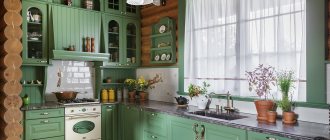A laundry room allows you to make life in a private home more comfortable by freeing the kitchen and bathroom from the washing machine and creating a full-fledged storage system here. Its design and location must be determined at the stage of planning the house. This will allow you to think through its arrangement in advance and carry out all the necessary communications here.
Features of the laundry room
This room is used to house a washing machine, dryer and ironing. It is also convenient to store detergents and various household chemicals here. The following must be present in the room:
washing machine (depending on financial capabilities, there may be one or several with different functions); a cabinet or special device for drying clothes and clothes; cabinets for storing buckets, rags, a vacuum cleaner; ironing board with iron; shelves for storing brushes, cleaning supplies and household products; a sink where you can wash your hands or shoes, pre-soak your laundry; baskets for dirty things; storage systems.
The room can be combined with a change room or storage room. If there is a lack of free space or when setting up a laundry room in an ordinary apartment in a multi-storey building, it can be placed next to the kitchen or bathroom.
Advantages of the premises
A separate laundry room has many advantages. First of all, this:
Ease of use. If all the items for washing, drying and ironing are placed in one place, it will be much more convenient to use them than having a separate washing machine in the bathroom, dryer on the balcony and ironing board in the bedroom. Space saving. By placing everything compactly within one room, you will be able to free up space in other rooms. Aesthetics. The apartment will be much more comfortable if it does not have separate dryers, ironing boards or shelves with household chemicals.
Putting things in order
Before you start developing the design of a pantry, laundry room or utility room, you need to conduct an audit in this wonderful corner and get rid of unnecessary trash. Of course, if the apartment was not purchased in a new building. We bring to your attention several useful recommendations that will help you transform your utility room on a budget:
- Spring-cleaning. It has already been mentioned earlier. Without cleaning, it will not be possible to rationally plan the space.
- Redecorating. Usually there are no window openings in the pantry, so the room especially needs antifungal and antibacterial treatment. The most suitable material for furnishing the interior of a pantry is ceramic tiles, which cover both the walls and the floor.
- Providing a ventilation system. To maintain a normal level of ventilation in the room, install a modern ventilation system.
- Lighting. A windowless room needs good lighting. An ideal option for a pantry is a luminescent module.
Organization of space in the laundry room
How the space in the laundry room will be organized depends on the area of the room used. In a small room with an area of 4-8 square meters, you can place only the necessary items, which include washing and drying machines and other necessary items.
When designing cabinets or wall shelves, you need to consider the convenience of storing household equipment. In this case, you need to take into account the ergonomics of the space, leaving enough space so that work processes (loading the washing machine, ironing, hanging things on the dryer and other work) can be carried out conveniently.
If home owners have the opportunity to make laundry cabinets to order, then they should take advantage of this. This will allow you to make a product that will be optimally suited both in size and functionality. To make the room as spacious as possible, it is necessary to use even the hidden corners of the room.
If very little space is allocated for the laundry room, light colors in the decoration of walls, ceilings and other surfaces will help expand the space in it.
Ordinary
This laundry room is not only beautiful, but also functional. The machines are installed on a podium with compartments for laundry baskets, designed according to an individual project.
Give free rein to your imagination. Freestanding laundry rooms are places that allow for bold design experiments. Brightly colored walls, funky wallpaper, and tiles with playful patterns are just some of the decor options that might not look out of place in any other part of your home.
Where to arrange a laundry room?
When choosing the best place to place a laundry room in a private house, you need to take into account that there should be high-quality ventilation, good heating, and proximity to communications. It would be ideal if there was a small window in it. This will ensure high-quality ventilation, avoid the pungent smell of household chemicals and laundry detergents, and things will be able to dry faster.
Therefore, the best place to place a laundry room is considered to be the room adjacent to the bathroom, kitchen, or toilet. In a large country house, it is allowed to use a heated room in the basement for these purposes. In the event that there is no free space in the house for arranging a laundry room, it can be placed along the wall under the stairs.
Ventilation
Exhaust fans must be installed. This will definitely keep your room odor-free and you won't have to worry. Now they are creating innovative products with an exhaust fan that prevents the appearance of unpleasant odors. Advanced technology is used to operate with less power. This offers energy saving benefits. Mounting brackets provide quick installation. In fact, it allows you to position the fan according to your requirements. Silent exhaust fans can produce a maximum airflow of 110cc.
Laundry room size
When allocating a separate room for the construction of a laundry room, you should first decide on its size. If the area of the house does not exceed 100 square meters, then the laundry room should not be more than 2 square meters. In this case, it will look like a built-in closet, where the storage system and the necessary equipment will be placed along one wall. When arranging furniture, it is important to consider the sequence in which the main work processes will be carried out.
For convenience, a basket for dirty things is placed directly near the exit. Next will be the sink. Next, place a washing machine, heated towel rail or a special board for ironing clothes. The arrangement may be different, depending on individual preferences and the placement of the water supply system, but this is considered the most convenient and ergonomic.
If the area of the house is about 150 square meters, then you can allocate about 6 square meters for the laundry room, placing here not only a storage system and a washing machine, but also a sink, countertops and shelves.
In a house whose area exceeds 350 square meters, it will be possible to allocate more than 10 square meters for a laundry room. In such a room you can, among other things, place a drying cabinet and even a place for repairing clothes with a sewing machine and other equipment. And to brighten up the household chores, a soft corner and a TV are installed in such a spacious room.
Traditional
The short hallway in this small home is the perfect place to place the washer and dryer. An inexpensive plywood tabletop can be used for sorting and storing things. The location of the washing corner near the terrace and backyard will allow you to dry your clothes with fresh air from the street.
This multifunctional space doubles as an entryway, living room, office and laundry room. A built-in sofa, table and cabinet help keep things neat and tidy without cluttering the space.
Design options
The laundry room follows the same design as the rest of the house. But sometimes there are also combined options that will harmoniously combine with other rooms. For example, if the renovation of the house is done in a classic style, then the laundry room can be decorated in a country style. And brutal loft goes well with fusion, minimalism, Scandinavian, etc. trends.
The shade of furniture and surfaces is selected based on the prevailing color scheme in the house. For a classic interior, white or other light colors would be appropriate. All of them are capable of visually making the room larger, cleaner and more festive.
Natural shades of wood will look good in loft, country, and minimalist styles. Elegant gray can be used to paint walls and furniture in a room that receives plenty of sunlight.
The blue palette makes the room softer and more spacious. Rich blue will look good next to white. This combination has a good effect on your mood and puts you in a working mood.
Olive, peach, mint and other pastel colors fill the atmosphere with calm and tranquility. But to prevent the room from becoming too boring, it is recommended to use bright details (lamps, curtains, various accessories). They can be updated periodically, bringing new, fresh notes into the room.
When decorating the interior of a laundry room, you must adhere to certain rules:
It is better to place the washing machine on a hill if it has a vertical loading type. If the laundry room is very small and there is not enough storage space, it is recommended to consider creating niches in the wall. In such a recess you can place a washing machine, dryer or cabinet. To save space, the washing machine is placed in a built-in closet.
If everything is arranged correctly, then such a room will be comfortable to work and pleasant to be in.
Aspergillus fungus
Excessively humidified air creates favorable conditions for the proliferation of aspergillus (aspergillus) - a genus of higher aaeobic (that is, oxygen-requiring) mold fungi. There are hundreds of its varieties, but in homes it is more often found in the form of yellow-green mold or mold in the form of a white fluff with a black or gray core.
The fungus is especially partial to:
- leaking batteries in old houses;
- heating pipes hidden in the walls;
- rooms with poor ventilation.
There are several hundred species of the mold Aspergillus
What is the danger
If there are disturbances in the functioning of the body's systems, too humid air can lead to serious consequences. Drying wet laundry in an apartment is especially dangerous for those who have a history of:
- pulmonary diseases (spores released by mold to reproduce are a powerful allergen that can cause coughing, runny nose and even asthma);
- allergies (in addition to the above-mentioned complications, during the drying process the laundry evaporates the remaining detergent and conditioner - impurities that can also cause allergies);
- weakened immunity caused by chronic cancer, as well as AIDS (such patients may develop aspergillosis, a disease that affects the oral cavity, respiratory system, nervous system and can lead to death).
People with strong immune systems can be carriers of aspergillosis. In other words, mold colonizes on them, provoking the appearance of aspergilloma - a pea-shaped fungus located on the surface of the mucosa. Aspergilloma is removed promptly.
Mold spores are dangerous for children, especially newborns who have not yet developed immunity.
Weak immunity makes a person vulnerable to aspergillosis
Symptoms of spore infestation
There is a whole range of signs that can be used to suggest that a person is infected with Aspergillus.
- Runny nose.
- Heat.
- Shortness of breath, chest pain.
- Permanent fatigue.
- Stinging in the eyes.
- Constant cough, sometimes with blood clots.
- Sore throat.
- Migraine.
- Nausea.
- Skin irritations.
The final diagnosis, after a thorough examination of the anamnesis and tests, can only be made by a specialist of a suitable profile: a pulmonologist, otolaryngologist, ophthalmologist or mycologist (a doctor who treats skin diseases caused by yeast or mold fungi).
Drying clothes in the air not only gives clothes a unique freshness, but also does not have a negative effect on the level of humidity in the house
Using the dryer
A laundry room in a private home can be used not only for washing or drying linen, clothes and other things. For these purposes, a dryer is installed here in the form of a wooden section built into a cabinet or a mobile metal structure. To make it convenient to hang dresses, jackets and other things here, the dryer should be equipped with hangers, for which a rod can be specially installed, fixed between the wall cabinets. To place it, choose a convenient location. For example, above the sink.
Even if the laundry room has a drying machine and a closet, it is worth purchasing a small mobile dryer or heated towel rail, which are convenient to use for small items.
Very small corner
This can also be done in the bathroom.
The washing machine is installed under the countertop, but is not built into it (you can see the guides for the countertop and assume that it is height adjustable). Next to it is a laundry basket, above the appliances there is a shelf and a rail that is attached to the wall, with hangers for hanging things to dry.
Drying things in a small bathroom is not always a good idea; there is a high risk of creating additional dampness. If this is the only opportunity not to block rooms with floor dryers, it is worth considering good ventilation.
Choosing a sink for the laundry room
It needs to be installed next to the washing machine, since the sink will also need a water supply and drainage system. To make it convenient to soak clothes here, the sink must be deep enough. If you don’t plan to do this, you can choose a small size. If the area of the room allows, it is possible to install several sinks at once. For example, one can be used for washing clothes, the other for cleaning outdoor shoes, washing hands, collecting water, or other purposes.
The type and material from which the sink is made may depend on personal preference and functionality. It can be made of stainless steel, ceramics or artificial stone.
Storage options for linen and household chemicals
To compactly place everything you need and at the same time save free space for storing household supplies, it is recommended to use:
pockets on the cabinet door or wall for small items; numerous shelves hung on the wall to accommodate rags, sponges, jars and boxes; niches in the wall for placing cabinets or shelves; wall hooks or towel racks; pull-out cabinets for linen or household items.











